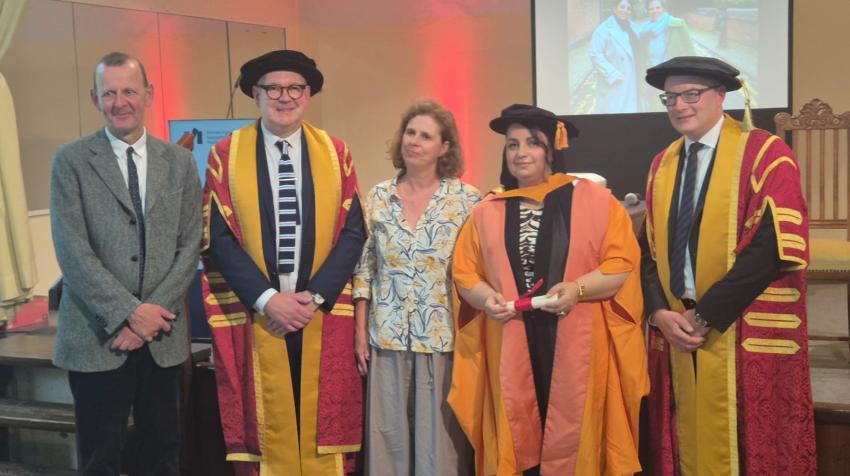“Bera Bond” is the most recent book from Sundeep Bhutoria, the quietly energetic Treasurer of WFUNA, the World Federation of United Nations Associations, a wildlife wanderer and fleetographer, one of whose evocations of energy and calm this photograph, taken in the leopard country of Bera in India, represents so gently. And, at this vernal moment of the year, it has its own compelling chronology; this Sunday, March 21, is the International Day of Forests, Monday, the 22nd World Water Day, and Tuesday the 23rd, World Meteorological Day - all elements finding quite literal reflection in the image.
I have often, and in vain, tried to reconcile the soar and splendour of the UN Charter, whether voiced by Laurence Olivier or simply silently savoured on an enthralled enchanted evening, with the ploddingly purposeful, pedestrianally prosaic names given to so many of the Organization’s bodies. “Bodies” is an apt word, the first image that leaps to mind when reading about the “Joint Inspection Unit” (JIU) is the orthopedic ward of a harried hospital, and your features frown with furtive figures when stumbling upon the “Statistical Commission, both conclusions grossly unfair to entities that have consistently lived beyond the misfortune of their names. (I say this in all humility, having worked in what used to be called the “Department of Public Information”, a title that sounded earnest and helpful, like a kiosk at a busy railway station, but little more).
As we saw on two occasions this month, both related to this celebratory week on our environment. As “the only independent external oversight body of the United Nations system mandated to conduct evaluations, inspections and investigations system-wide”, JIU’s “Review of mainstreaming environmental sustainability across organizations of the United Nations system”, prepared by Gopinathan Achamkulangare, commands ready attention and is based on a simple premise, “as custodian of the conventions, treaties and norms concerning climate change, environmental protection, the pollution of the air, water and oceans and related areas, and as the chief advocate of sustainable development in all its aspects, the United Nations system should be seen to practice internally in the different management areas what it preaches to the outside world. The organizations of the United Nations system should move away from advocacy practices aimed merely at raising awareness and should instead assume responsibility for implementing the 2030 Agenda within their own operations and activities.” And it begins with a straightforward question: will we remain prisoners of the past, or strive to become harbingers of a sustainable future?
What the magisterial, but readily readable, report does particularly successfully is link the reputational rewards of working towards the SDGs “at home” to the pluralistic plus of furthering the health and well-being of the Organization’s staff. A particular instance is travel, policies on which the report recommends review since they “have been developed with cost savings as a primary consideration, irrespective of considerations of personal health, well-being or inconvenience of the staff member. The environmental footprint of any travel undertaken has not been found to be a factor in the design of travel policies.” The report also argues, without equivocation, for change that can be incrementally qualitative rather than immediately quantitative, as in the area of procurement where “the time is right to take a close look at the underlying philosophy and tenets behind the current policies and practices and to fashion a more judicious approach to procurement that is underpinned by sustainability considerations beyond the simple adherence to “international competitive bidding”.
Suggesting the UN “should fully seize the opportunities arising from the ongoing global COVID-19 pandemic for serious digitalization,” the report makes specific recommendations to be realized over the next twenty months. These include, by the end of 2022, following the recent example of the World Intellectual Property Organization (WIPO) to go completely paperless by not using paper or printing, transmitting all communications, letters, documents and reports electronically; transforming all conferences, events and meetings to “paper smart”; making all official documentation, reports, publications, brochures, publicity, and communication and advocacy materials available only online and discouraging the display of such printed products at any events, conferences or meetings organized by all United Nations entities; ensuring all traditional post-event reports and communications are accessible only online and ensuring a comprehensive behavioural change by applying the new policies to all programmatic activities, including those funded by Member States through extrabudgetary, earmarked or voluntary contributions.
In many senses, the JIU report, authored by a veteran of intergovernmental negotiations on sustainability and the environment, comes full circle in asking the Organization that so assiduously winnowed the wealth of scholarship, innovation and research to the possibilities of policy, at a global level, to bring their practice home. Precedent is not reassuring; in the 15 years from 2005 to 2019, JIU presented 107 system-wide reviews to the General Assembly which adopted a single resolution in respect of one of them.
But these are not precedented times. It has been a year since United Nations offices all around the world, like so many others, closed physical access. Over these twelve “virtual” months, 6.4 million pages of UN documents and publications were digitized . UN Information Centres translated and published information digitally in 127 languages. 10,000 guests participated in virtual tours and briefings hosted by our Visitors’ Service. It is estimated about 14% of deforestation goes into paper products, destroying around 4.1 million hectares of forest each year, an area the size of the Netherlands. And if International Day of Forests 2023 sees a paperless UN, building upon the unintended successes of this past year, with its direction decisive, its commitments not cautiously conditional, we may yet see the trees for the woulds.
In a study on “Forests and Climate Change”, Dr. Duncan Brack notes “measures aimed at reducing current rates of deforestation and degradation including the development of production techniques not associated with deforestation, and measures designed to promote the consumption of zero-deforestation and/or sustainable products,” echoed in the JIU report. And in that endeavour, the interface between academic scholarship and national, as well as intergovernmental, action has proved its leadership; as Mita Sen of the UN Forum of Forests says “the 2019 landmark report from the Intergovernmental Science-Policy Platform on Biodiversity and Ecosystem Services sounded the alarm that the health of our ecosystems is declining at unprecedented rates and the rate of species extinctions is accelerating. If we wish to take action to turn the tide, sustaining forests are a critical part of the equation.”
The business sector has opted to support research as well; earlier this month, the International Paper Company announced that since the time of the 2019 report “six programs at four universities were selected for grant funding. North Carolina State University (NCSU) and Mississippi State University are researching timber supply modelling with the ultimate goal of improving market models that predict resource trends and prices. Virginia Tech and Texas A&M are exploring remote sensing technologies that will help characterize forest attributes. Virginia Tech is evaluating satellite and aerial imagery to estimate stand characteristics over large areas, whereas Texas A&M will be studying the use of space-borne and aerial sensors. Mississippi State University and NCSU are also conducting a comparative assessment of global wood fiber production.”
Which brings to mind the “75 UN – 75 Trees UNAI SDG 7” launched last year by UNAI Hub for SDG 7, KEPA, and its dynamic Professor Dimitrios Mavrakis in the context of the 75th anniversary of the United Nations; at the end of 2020, the initially set target of 1 million trees was dramatically surpassed; official commitments to plant trees have reached 11 million. UNAI Hub SDG7 now aspires, in 2021, to a "Global REED+ Actions” campaign including tree plantations, forest conservation, carbon stock enhancement through reforestations, agroforestry and silvopastoral systems. (If interested to join the initiative, please email KEPA at epgsec@kepa.uoa.gr and unai.hub.sdg7@kepa.uoa.gr).
Will that campaign, and the fresh greenness of its shoots, be a symbolic affirmation of a world beyond COVID, a world reborn? At the 2021 SDG conference hosted by UNAI’s hub on SDG 14, the University of Bergen, Professor John Kurien from the Azim Premji University in India argued that “ocean communities should be included in post pandemic recovery plans. Coming at a time of resurgent nationalism, this is the time to stress multilateralism. Countries must harmonize work on global ocean governance.” Will World Water Day 2022 seize the tide?
But to return to our second body (and to have a really engaging sense of it, do watch the conversation John Sebesta of the UN Chronicle had with the Director of the UN Statistics Division, Stefan Schweinfest), it was also this month that the United Nations Statistical Commission adopted “a new framework that includes the contributions of nature when measuring economic prosperity and human well-being; the System of Environmental-Economic Accounting - Ecosystem Accounting (SEEA EA)” dramatically expanding the instinctive but infirm indicator of gross domestic product (GDP) as the mark of measurement; the new standard “would ensure that natural capital - forests, wetlands and other ecosystems - are recognized in economic reporting. Experts emphasize that while a statistic such as GDP does a good job of showing the value of goods and services exchanged in markets, it does not reflect the dependency of the economy on nature, nor its impacts on nature, such as the deterioration of water quality or the loss of a forest.”
A stark sentence, scientifically and statistically . And spiritually, suggesting (as Jim Reeves did) that humans are capable of diminishing and destroying what no humans could create. Its last two elements , related to the Days this week, are also captured in a demonstrative scenario, that “a forest actually delivers a valuable service to nearby households and businesses by serving as a water filtration system for rainfall before it reaches streams and rivers.” Like Sundeep’s photograph, a powerful image, true in itself and as a metaphor. In a world where environmental responsibility is so ably and adventurously exercised at so many community and personal levels, we do need an agency which, like the forest, serves to filter and channel those ideas before they reach the streams and rivers of concerted global action. That agency is the United Nations and, if its reach within proves as purposeful as its reach without, the global sustainability movement will only be enriched, as we blue the green.
Ramu Damodaran
Chief, United Nations Academic Impact




